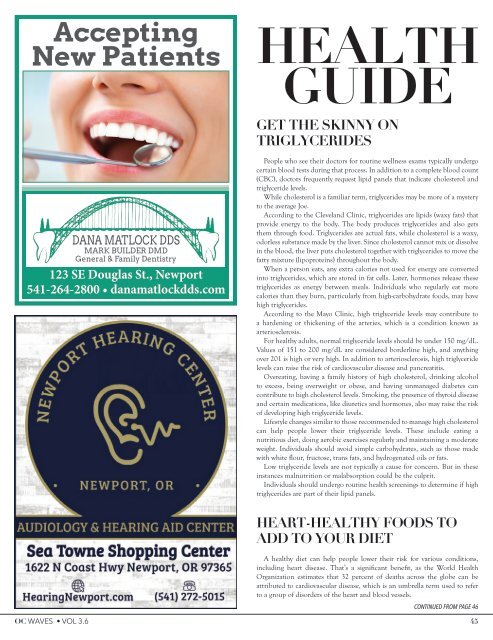OC Waves Vol 3.6
Premium monthly magazine serving the Oregon coast
Premium monthly magazine serving the Oregon coast
You also want an ePaper? Increase the reach of your titles
YUMPU automatically turns print PDFs into web optimized ePapers that Google loves.
Accepting<br />
New Patients<br />
HEALTH<br />
GUIDE<br />
GET THE SKINNY ON<br />
TRIGLYCERIDES<br />
DANA MATL<strong>OC</strong>K DDS<br />
MARK BUILDER DMD<br />
General & Family Dentistry<br />
123 SE Douglas St., Newport<br />
541-264-2800 • danamatlockdds.com<br />
People who see their doctors for routine wellness exams typically undergo<br />
certain blood tests during that process. In addition to a complete blood count<br />
(CBC), doctors frequently request lipid panels that indicate cholesterol and<br />
triglyceride levels.<br />
While cholesterol is a familiar term, triglycerides may be more of a mystery<br />
to the average Joe.<br />
According to the Cleveland Clinic, triglycerides are lipids (waxy fats) that<br />
provide energy to the body. The body produces triglycerides and also gets<br />
them through food. Triglycerides are actual fats, while cholesterol is a waxy,<br />
odorless substance made by the liver. Since cholesterol cannot mix or dissolve<br />
in the blood, the liver puts cholesterol together with triglycerides to move the<br />
fatty mixture (lipoproteins) throughout the body.<br />
When a person eats, any extra calories not used for energy are converted<br />
into triglycerides, which are stored in fat cells. Later, hormones release these<br />
triglycerides as energy between meals. Individuals who regularly eat more<br />
calories than they burn, particularly from high-carbohydrate foods, may have<br />
high triglycerides.<br />
According to the Mayo Clinic, high triglyceride levels may contribute to<br />
a hardening or thickening of the arteries, which is a condition known as<br />
arteriosclerosis.<br />
For healthy adults, normal triglyceride levels should be under 150 mg/dL.<br />
Values of 151 to 200 mg/dL are considered borderline high, and anything<br />
over 201 is high or very high. In addition to arteriosclerosis, high triglyceride<br />
levels can raise the risk of cardiovascular disease and pancreatitis.<br />
Overeating, having a family history of high cholesterol, drinking alcohol<br />
to excess, being overweight or obese, and having unmanaged diabetes can<br />
contribute to high cholesterol levels. Smoking, the presence of thyroid disease<br />
and certain medications, like diuretics and hormones, also may raise the risk<br />
of developing high triglyceride levels.<br />
Lifestyle changes similar to those recommended to manage high cholesterol<br />
can help people lower their triglyceride levels. These include eating a<br />
nutritious diet, doing aerobic exercises regularly and maintaining a moderate<br />
weight. Individuals should avoid simple carbohydrates, such as those made<br />
with white flour, fructose, trans fats, and hydrogenated oils or fats.<br />
Low triglyceride levels are not typically a cause for concern. But in these<br />
instances malnutrition or malabsorption could be the culprit.<br />
Individuals should undergo routine health screenings to determine if high<br />
triglycerides are part of their lipid panels.<br />
HEART-HEALTHY FOODS TO<br />
ADD TO YOUR DIET<br />
A healthy diet can help people lower their risk for various conditions,<br />
including heart disease. That’s a significant benefit, as the World Health<br />
Organization estimates that 32 percent of deaths across the globe can be<br />
attributed to cardiovascular disease, which is an umbrella term used to refer<br />
to a group of disorders of the heart and blood vessels.<br />
CONTINUED FROM PAGE 46<br />
<strong>OC</strong> WAVES • VOL <strong>3.6</strong><br />
45
















